Over the past few decades, changes in weather patterns due to climate change or global warming have led to more extreme, frequent, and costly weather events that have included intense rains, ice storms, tornadoes, floods, hurricanes, heat waves, droughts, and wildfires. These events have caused hundreds of major power outages which have closed schools, shut down businesses, impeded emergency services, and cost the economy hundreds of billions of dollars. In an effort to combat the growing problem, many utilities are developing strategies to modernize and ‘harden’ the electric grid. New initiatives are directing substantial investment to improve the grid’s efficiency, capacity, reliability, and resiliency. These efforts will not only help make the grid less vulnerable to weather-related outages, they will also help reduce the time it takes to restore power after this number-one cause of outages occurs.
Climate change, more commonly referred to as global warming, is a significant, lasting, and statistically-measurable change in weather patterns that can last from a few decades to thousands of years. It can generally be attributed to variations in solar radiation due to changes in solar output, orbital variations, and atmospheric conditions, among others. Volcanos, for instance, are known to have been a major cause of climate change throughout the ages. In the last several decades, human (anthropogenic) activities have also been associated with climate change. These activities include an increase in CO2 levels due to fossil fuel combustion, the manufacture of cement, and deforestation. These also include ozone depletion due, in part, to the catalytic effect of man-made refrigerants, solvents, and propellants. While many people feel that anthropogenic influences are negligible, the scientific consensus is that the climate is changing and that human activities are playing a substantial role.
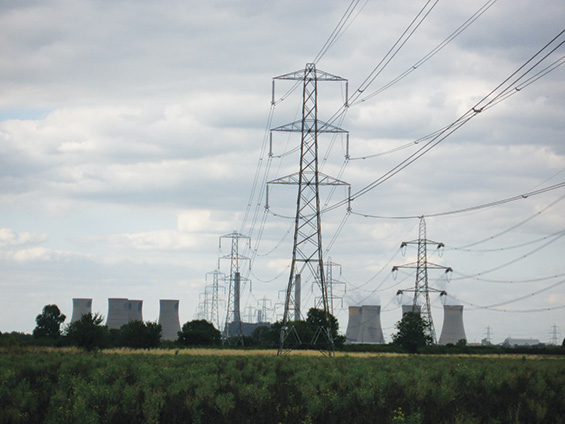
High-capacity ACCC
In Texas, for instance, statistics suggest that severe droughts are several times more likely to occur today than they were in the 1960s due to climate change. Higher temperatures lead to increased evaporation, adding moisture to the atmosphere, which can intensify storms. As the planet’s temperature continues to rise and glaciers recede, sea levels are also rising measurably. This is most certainly putting coastal areas and the utility infrastructure at greater risk.
In October 2012, the storm surge triggered by Hurricane Sandy caused record flooding along the coast of New York, New Jersey, and Connecticut. More than 8 million customers across 21 states lost power. Utilities reported damage to more than 15,000 power poles and 7,000 transformers. Following the storm, the city of New York discovered that nearly 40 percent of its transmission substation capacity and more than 10 percent of its large distribution substation capacity is at risk of flooding during extreme weather events.
Nationwide, dozens of major power plants and substations located along the coast are within a few vertical feet of high tide zones. As sea levels continue to rise, the risks to these facilities from storm surges will increase. Though predictions of sea level rises range widely, data compiled by the U.S. National Oceanic and Atmospheric Administration (NOAA) shows that rates of sea level rise have nearly doubled in recent years, suggesting a rise of two to six feet in the next century. With a warmer atmosphere, hurricane and storm rainfall is also projected to increase in certain areas, which is likely to increase runoff and flood risk on riverfront and other low-laying transmission and distribution facilities.
Higher air temperatures can also cause earlier snowmelts which can allow vegetation to become drier sooner, contributing to increased risk of wildfires. According to the United States Geological Service (USGS) the number of substantial wildfires in the Western United States rose from an average of 140 per year in the 1980s to more than 250 per year between 2001 and 2012. Eight of the ten largest wildfires in California’s history, in fact, have occurred since 2001. Drier conditions can not only cause wildfires to be more intense, they also tend to spread more widely and do greater damage. Though wildfires can damage transmission and distribution structures (especially wood poles), the greatest risk comes from smoke and particulate matter which can ionize the air, creating an electrical path from the transmission line to ground (structure, adjacent line, etc.) which can cause outages. Particulate buildup on insulators can have a similar effect.
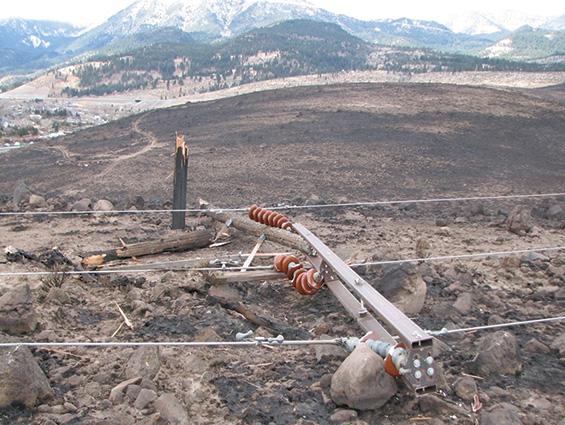
Firestorm damage – ACCC Conductor unharmed
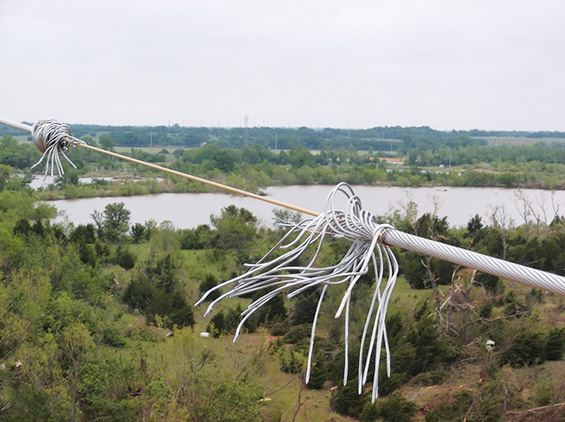
Storm damage – ACCC core remained undamaged
While climate change is increasing the frequency and severity of storms, and causing ice damage and flooding in some areas, rising global temperatures is also causing drought conditions and reduced water supplies in other areas. This has already become a problem for utilities whose generation plants require water for condensing steam and/or cooling, that are located in impacted areas. The problem should not be considered insignificant, as two-fifths of all freshwater consumed in the United States is currently used by coal, natural gas, nuclear, geothermal, biomass, and solar-thermal electric power plants that rely on water for cooling or steam generation to run turbines. A water shortage is not the only problem. Higher in-feed water temperatures caused by climate change can reduce a plant’s efficiency and/or capacity, while higher outgoing temperatures can negatively impact local ecosystems and cause the facility to fall out of compliance with federal or state regulations. When these conditions occur – often during periods of high electrical demand – generation may have to be tapered back or completely shut down.
Higher air temperatures can also impact generation plant efficiency. Thermal generation plants operate most efficiently when the air is cool. When this is not the case, more fuel must be consumed or chillers must be installed, either of which add costs to delivered power. As heat waves brought on by climate change are becoming longer lasting and more frequent in recent years, estimates suggest that existing thermal generation capacity may diminish by as much as 15 percent over the next few decades due to the impact of higher air and water temperatures. According to the NOAA, the past four decades have all been hotter than the twentieth century average, and nine of the ten hottest years on record have all occurred since 2001.
While higher ambient temperature tends to increase consumer demand, a loss of efficiency occurs with transmission and distribution equipment – as well as with generators – as temperatures rise. The efficiency of electrical conductors and transformers used for transmission and distribution, for instance, decrease as temperatures rise. Higher temperatures cause the electrical resistance of the conductive materials to climb. Increased resistance translates into increased line losses which are exacerbated by higher levels of electric current. Line losses are a function of the electrical resistance (R) of the wire multiplied by the electrical current (I) squared (I2R). While the cost of these losses is generally passed along to the consumer, generation capacity, fuel consumption, associated emissions, and water supply are all ‘spent’ supporting these line losses.
To protect the electric grid from severe weather events (the number one cause of outages), and ensure reliable delivery in the future, our industry will need to continue to develop and deploy new technologies and business models to support alternative investment strategies. Design standards, inspection methods, and construction guidelines will need to be reconsidered and more efficient means of assessing damage, deploying crews, and retrieving a possibly larger inventory of standardized parts will most surely require consideration. Developing more robust critical infrastructure components such as traffic signals and installing backup generators for key institutions may also prove highly cost effective. Utilities less enthusiastic about employing new technologies may need to rethink the risk-reward equation, and entities that assess new technologies may want to consider ways to fast track their evaluations that can otherwise get caught on academic treadmills.
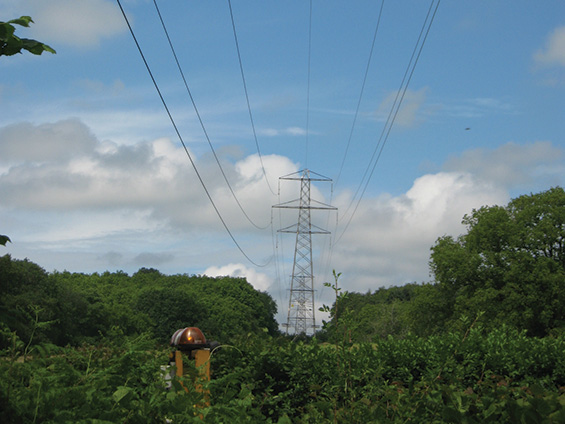
Sag comparison ACSR and ACCC
A first line of defense has always been to squeeze more out of less. For decades, utilities have found it very advantageous to improve the efficiency of generators to reduce operating costs. More recently, incentives have been provided to inspire consumers to use more energy-efficient appliances and build more energy-efficient homes and work places. These strategies have helped defer additional, more expensive investment in building new generation to support growing demand. The same strategy can be used on the grid itself, where a substantial amount of energy is lost during the transmission and distribution of electricity. A new bare overhead conductor that was initially developed to handle very high levels of current (during emergency conditions) with very low thermal sag due to its hybrid carbon fiber composite core (ACCC) was also found to reduce line losses by 25 to 40 percent or more compared to other conductor types of the same diameter and weight during normal operating conditions. While its high-capacity and high-strength have helped improve grid reliability and resiliency in the wake of several heat waves, storms, fires, and tornadoes, its improved efficiency is also helping reduce fuel consumption and carbon emissions, while ‘freeing up’ generation capacity. Employing energy efficiency measures on the generation side, the demand side, or on the grid itself may offer practical solutions for both adapting to – and mitigating – challenges associated with climate change.
Utilities are taking other steps to ‘harden’ the grid which include building protective sea walls or restoring naturally occurring defenses such as:
- Sand dunes and wetlands
- Elevating or relocating important electrical equipment to protect them from flooding
- Installing smart grid technologies and switches that can redirect power to undamaged sections of line and isolate problem areas
- Undergrounding transmission and distribution lines where feasible
- Reinforcing or replacing above ground poles with more robust alternatives to reduce storm and fire damage
- Improving vegetation management efforts.
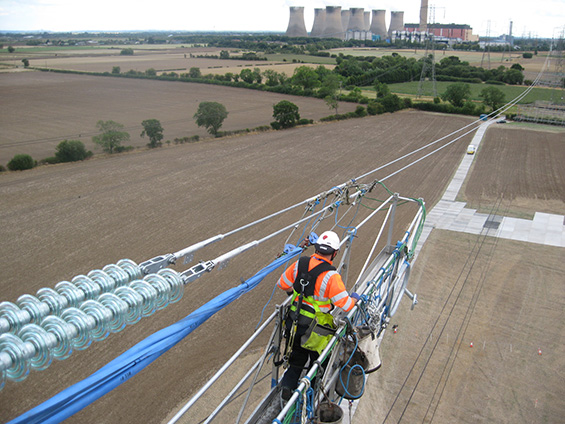
Power plant upgrade
As there are always costs associated with these and other options, many alternatives and combinations of these techniques are generally considered on a system wide basis.
To help make the grid more flexible and resilient during heat waves and periods of high demand, a number of utilities and grid operators are also implementing ‘demand-response’ programs, which incentivize commercial and industrial consumers to cut electricity use during periods of unusually high demand. During a record setting heat wave in September 2013, for example, the PJM grid operator used demand-response to curb demand by six gigawatts. This was the equivalent savings of roughly 10 coal-fired power plants, which helped keep the grid stable and air conditioners running when they were most needed.
Utilities and grid operators are also pursuing other approaches to help make the grid more flexible, robust, and resilient by expanding transmission capacity, integrating energy storage, and improving forecasting and scheduling techniques. Adding transmission capacity serves not only to improve grid reliability and efficiency, it can also help reduce congestion costs – allowing the consumer access to the least expensive or cleanest source of power. Also, when a conductor on a section of the grid is replaced with a more efficient conductor, the new conductor serves to reduce ‘stress’ on adjacent sections of the grid to further improve overall grid efficiency.
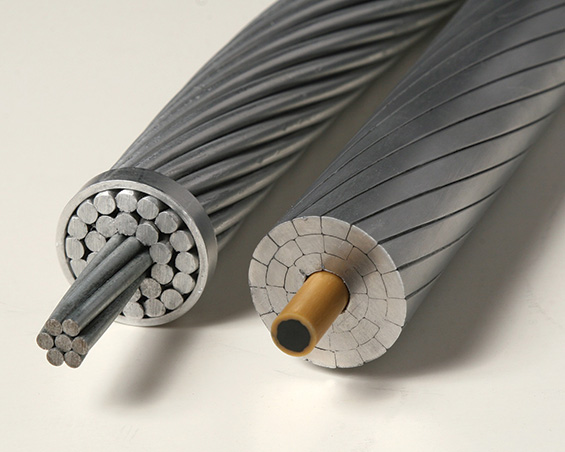
Conventional ACSR and modern ACCC conductor
Another important component of reducing the impact of weather related outages and improving grid resiliency – or the ability to quickly restore it following an outage – relates to communication. In many respects, this is where the smart grid strategy comes into play. In many instances, utilities that are faced with storm damage are using data to identify and quickly respond to problem areas in much quicker timeframes with much success. As it relates to reducing the impact of weather-related outages, efforts are also being directed to helping customers better understand the nature of outages and how they can best prepare themselves, or secure assistance, when outages occur. Though climate change will continue to increase the frequency and severity of storm related outages, we now have many tools at our disposal to minimize the impact.
About the Author
 Dave Bryant is director of technology at CTC Global and was one of the original developers of the high-capacity low-loss ACCC conductor and ancillary hardware components. He can be reached at dbryant@ctcglobal.com.
Dave Bryant is director of technology at CTC Global and was one of the original developers of the high-capacity low-loss ACCC conductor and ancillary hardware components. He can be reached at dbryant@ctcglobal.com.







